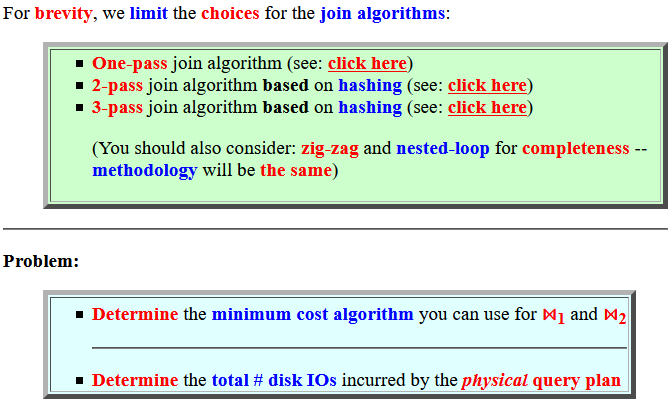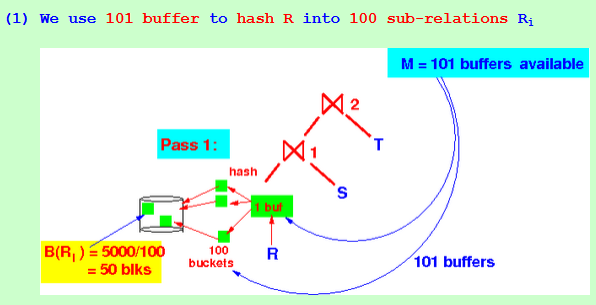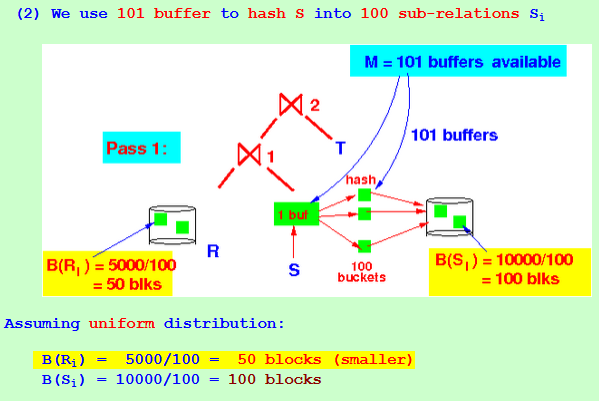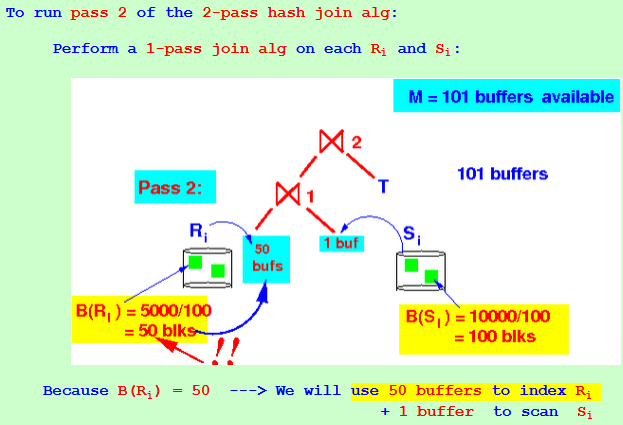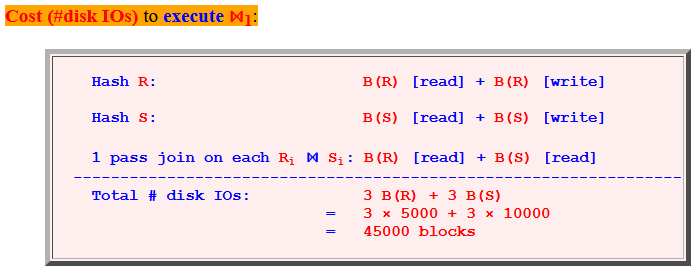Slideshow:
- Consider the following
modified scenario
for
the same
query plan:
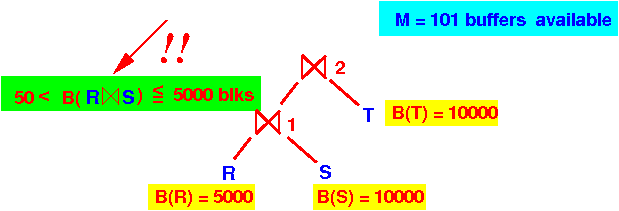
Relevant statistics:
- B(R) = 5000 blocks - clustered, no index on R
- B(S) = 10000 blocks - clustered, no index on S
- B(T) = 10000 blocks
-
clustered,
no index
on T
-
50 < B(R ⋈ S) ≤ 5000
- The result of
B ⋈ S is
pipelined to
⋈2
(⋈2 reads one tuple from B ⋈ S at a time
- The result of
B ⋈ S is
pipelined to
⋈2
- Available buffers = 101 blocks
- Choice
for the join algorithm:
- One-pass join algorithm (see: click here)
- 2-pass join algorithm based on hashing (see: click here)
- 3-pass join algorithm based on hashing (see: click here)
- Problem:
- Determine
the minimum cost algorithm
you can use for
⋈1 and
⋈2
- Determine the total # disk IOs incurred by the physical query plan
- Determine
the minimum cost algorithm
you can use for
⋈1 and
⋈2
- Step 1:
check if
we can use a 1-pass algorithm
for ⋈1:
-
We have performed this
check
before:
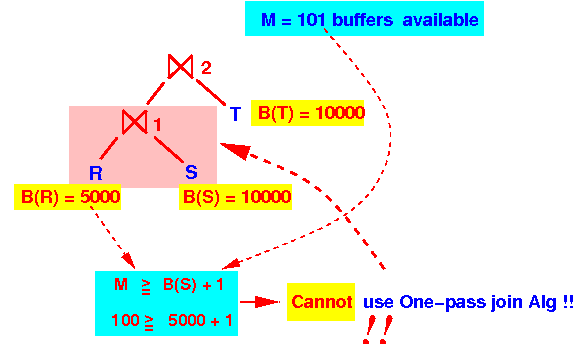
Since:
M = 101 < 5001We cannot use a 1-pass algorithm for ⋈1
-
We have performed this
check
before:
- Step 2:
check if we can use
a
2-pass (hashing based)
join algorithm for
⋈2
-
We have performed this
check
before:
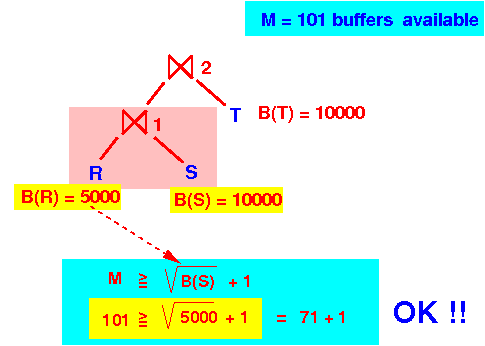
How is the ⋈1 executed:
Pass 1 of the 2-pass hash join alg: (1) We use 101 buffer to hash R into 100 sub-relations Ri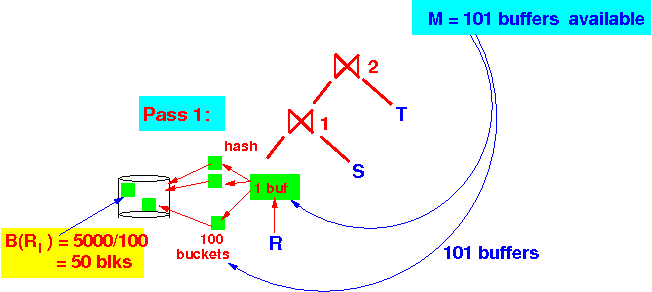 (2) Use 101 buffer to hash S into 100 sub-relations Si
(2) Use 101 buffer to hash S into 100 sub-relations Si
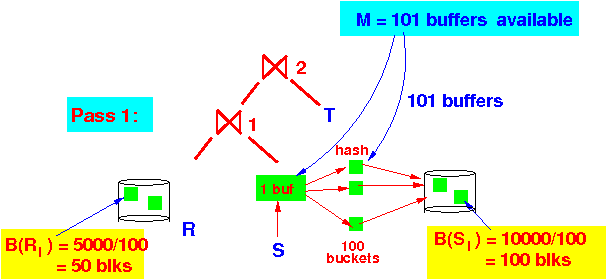 Assuming uniform distribution:
B(Ri) = 5000/100 = 50 blocks (smaller)
B(Si) = 10000/100 = 100 blocks
Assuming uniform distribution:
B(Ri) = 5000/100 = 50 blocks (smaller)
B(Si) = 10000/100 = 100 blocks
Pass 2 of the 2-pass hash join alg: Perform a 1-pass join alg on each Ri and Si: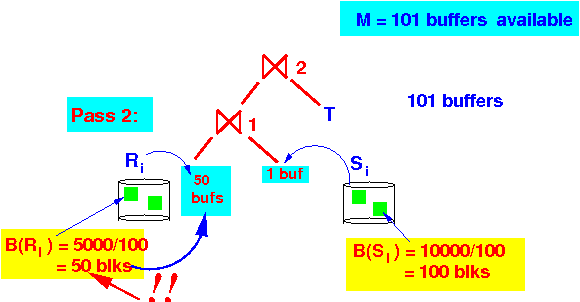 Because B(Ri) = 50 ---> We will only use 50 buffers to index Ri
+ 1 buffer to scan Si
Because B(Ri) = 50 ---> We will only use 50 buffers to index Ri
+ 1 buffer to scan Si
-
We have performed this
check
before:
-
Determine the cost (#disk IOs)
to execute
⋈1:
SAME !!!
Hash R: B(R) [read] + B(R) [write] Hash S: B(S) [read] + B(S) [write] 1 pass join on each Ri ⋈ Si: B(R) [read] + B(S) [read] ----------------------------------------------------------------- Total # disk IOs: 3 B(R) + 3 B(S) = 3 × 5000 + 3 × 10000 = 45000 blocks
-
Step 3:
determine the best suitable
join algorithm for
⋈2:
- We will get a different outcome because B(R ⋈S) > 50 (remaining buffers)
- Check if we can
use the 1-pass
join algorithm for
⋈2:
- Because the result is
pipelined,
the operator
⋈2 will
build the
search index
on its
first operand
while
the operator
⋈1
is active:
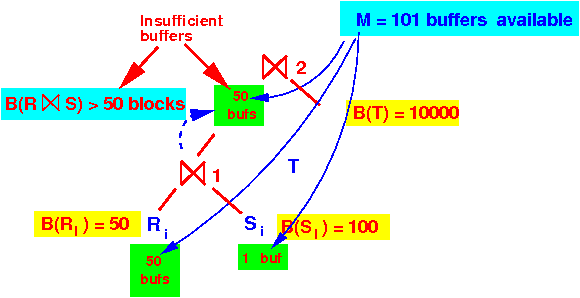
Observe that:
- We have 50 buffers remaining for ⋈2
- B(R ⋈ S) > 50 blocks
- Conclussion:
- We cannot to use one-pass join algorithm for ⋈2 !!!
- Because the result is
pipelined,
the operator
⋈2 will
build the
search index
on its
first operand
while
the operator
⋈1
is active:
- Next:
check if we can
use 2-pass
join algorithm for
⋈2:
- Note:
- The check is performed by running the 2 pass algorithm using M' = 50 buffers !!!
- In pass 1, the
2-pass hash algorithm will use the
remaining
50 (= 101 - (50 + 1)) buffers
as 50 buckets
and
hash
the input tuples
of R ⋈ S onto
disk:
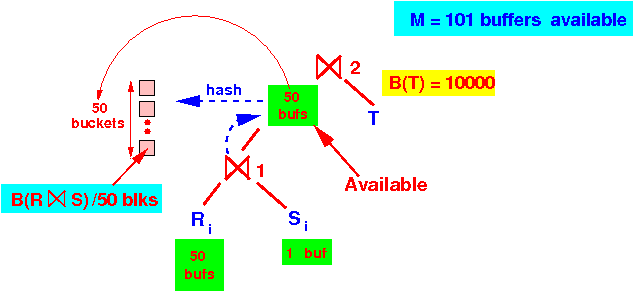
Each chunk Ri has the size B(R⋈S)/50 (≤ 100 blks !!)
After hashing B(R⋈S) (and write chunks to disk), we can free all buffers:
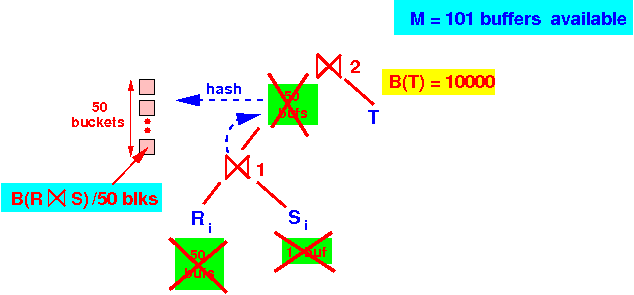
- We must use the
same number (= 50) of
buckets to
hash the
second operand T:
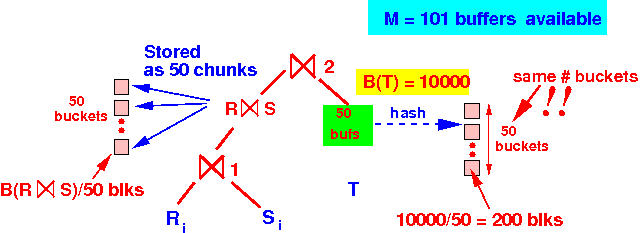
- After
we hash
the relation T:
- The left input sub-relations and the right input sub-relations is stored on disk !!!
Therefore, we can use all 101 buffers for the pass 2 of the hash-based join:

-
Phase 2 of the
hash-based join is the
one-pass
join algorithm
on each fragment pair ("chunk"):
- Each chunk has the size B(R⋈S)/50 which is ≤ 5000/50 = 100 blocks
- We have (M−1) = 100 buffers available !!!
So: 2-pass hash join will work !!!
Conclusion:
- If B(R⋈S) ≤ 5000, then we can use 2-pass hash-based join algorithm for ⋈2
- Note:
-
Cost (#disk IOs)
to execute
⋈2
(assuming
that 50 <
B(R⋈S) ≤ 5000):
Hash (R⋈S): 0 [pipelined read] + B(R ⋈ S) [hash/write Ri] Hash T: 10000 [read] + 10000 [write] Phase 2 hash join (R⋈S) ⋈ T: B(R ⋈ S) [read (R ⋈ S)] + 10000 [read T] ----------------------------------------------------------------------------- Total: 2 × B(R ⋈ S) + 30000
# disk IOs for ⋈1 = 45000 # disk IOs for ⋈2 = 2×B(R ⋈ S) + 30000 ------------------------------------------------------- Total # disk IOs = 2×B(R ⋈ S) + 75000 |

